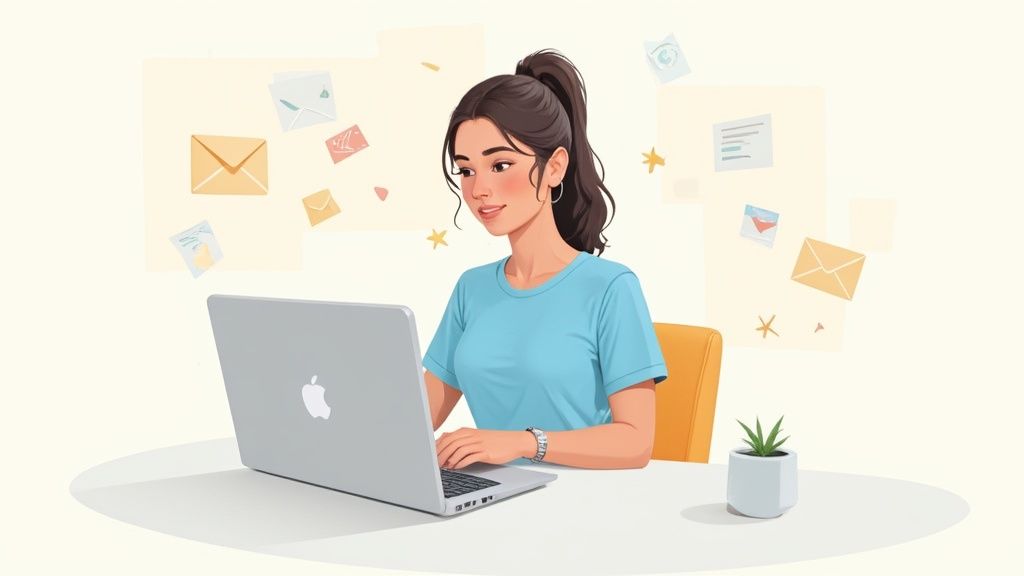
Effective After Interview Email Sample Tips to Stand Out
Published
Ace Your Follow-Up: After Interview Email Sample Options
A strong after interview email can be the deciding factor in landing your dream job. This article provides six after interview email sample options, covering various scenarios from standard thank yous to post-rejection re-engagement. Learn how to craft compelling follow-ups that reinforce your qualifications and keep you top-of-mind with recruiters and hiring managers, particularly crucial in competitive fields like influencer marketing. These samples will help you make a lasting impression and boost your chances of receiving a job offer.
1. Standard Thank You Follow-Up Email
The standard thank you follow-up email is the cornerstone of post-interview etiquette. Sent within 24 hours of your interview, this concise and professional message expresses gratitude for the interviewer's time and reiterates your strong interest in the position. It's the most common and widely accepted form of after interview email sample, reinforcing positive impressions and keeping you top-of-mind with hiring managers. This simple act of courtesy can significantly impact your chances of securing the job. It demonstrates professionalism, attention to detail, and genuine enthusiasm – qualities highly valued by employers.
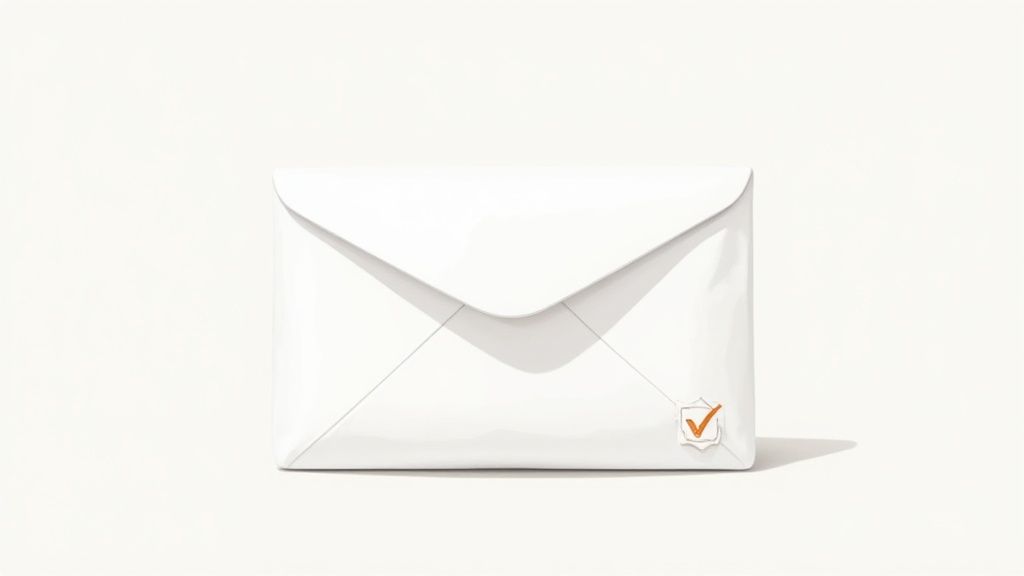
Following up after an interview is a crucial aspect of effective business communication. A well-crafted thank-you email can reinforce your interest, reiterate your qualifications, and leave a lasting positive impression. According to Effective Business Communication: A Research-Backed Guide to Workplace Success in 2024 from CartBoss, mastering these communication skills is essential for career advancement.
A well-structured standard thank-you email includes several key features. It should be brief and maintain a professional tone, expressing genuine gratitude for the opportunity to interview. It's also essential to reiterate your interest in the specific position discussed and, if possible, mention a detail or two from the conversation to demonstrate attentiveness. This personalization shows you were actively engaged during the interview and helps you stand out from other candidates.
The benefits of sending a standard thank you email are numerous. It demonstrates professionalism and courtesy, reinforces positive interview impressions, and shows attention to detail and follow-through. This practice is universally expected by employers and carries a very low risk of negative interpretation. For example, tech giants like Google and Microsoft consider these emails standard protocol, and Fortune 500 companies report that 90% of hired candidates sent thank you notes. LinkedIn surveys further corroborate this, revealing that 68% of hiring managers expect post-interview follow-ups.
However, the standard thank-you email isn’t without its drawbacks. If not personalized effectively, it can appear generic and fail to differentiate you from other candidates. It also offers limited opportunities to add new value to your application or further showcase your skills and experience.
So, when and why should you use this approach? The standard thank you email is appropriate for almost any interview situation, especially initial screening interviews or first-round interviews. It's a safe and effective way to maintain contact and demonstrate your professionalism. You can further enhance this type of after interview email sample by adding a sentence linking your skills to a specific company need discussed during the interview. Learn more about Standard Thank You Follow-Up Email for additional insights and examples.
To maximize the impact of your thank you email, follow these tips:
- Personalize: Include specific conversation details, such as referencing a project you discussed or a company challenge you’re eager to address. This helps the hiring manager remember your conversation and connects your skills directly to their needs. This is particularly relevant for roles in influencer marketing, digital strategy, or brand management where demonstrating a grasp of specific campaign details or industry trends can set you apart.
- Brevity is key: Keep it under 200 words. Hiring managers are busy, so a concise and impactful message is more likely to be read.
- Individualized Approach: Send separate emails to each interviewer. This demonstrates respect for their individual time and allows you to personalize the message based on your conversation with each person.
- Clear Subject Line: Use a clear subject line like "Thank you - [Position Title] interview" to ensure your email is easily identifiable and opened promptly.
- Proofread Carefully: Errors in grammar or spelling can undermine your professional image. Always proofread your email before sending.
For those pursuing careers in influencer marketing, social media, or content strategy, sending a timely and personalized thank-you note demonstrates not only professional courtesy but also the kind of meticulous attention to detail required for success in these fast-paced and competitive fields. Whether you’re an aspiring influencer, a seasoned marketing strategist, or a recruiter seeking top talent, understanding the nuances of the standard thank-you email can give you a significant edge in the hiring process.
2. Value-Added Follow-Up Email
A value-added follow-up email is a strategic approach to post-interview communication that transcends a simple thank you. Instead of just expressing gratitude, it provides additional value to the hiring manager by offering relevant resources, insights, or potential solutions to challenges discussed during the interview. This proactive strategy showcases your genuine interest in the organization and positions you as a thoughtful and resourceful candidate. It demonstrates that you're not just looking for a job, but that you're actively thinking about how you can contribute to the company's success. This type of after interview email sample can significantly boost your chances of landing the job.
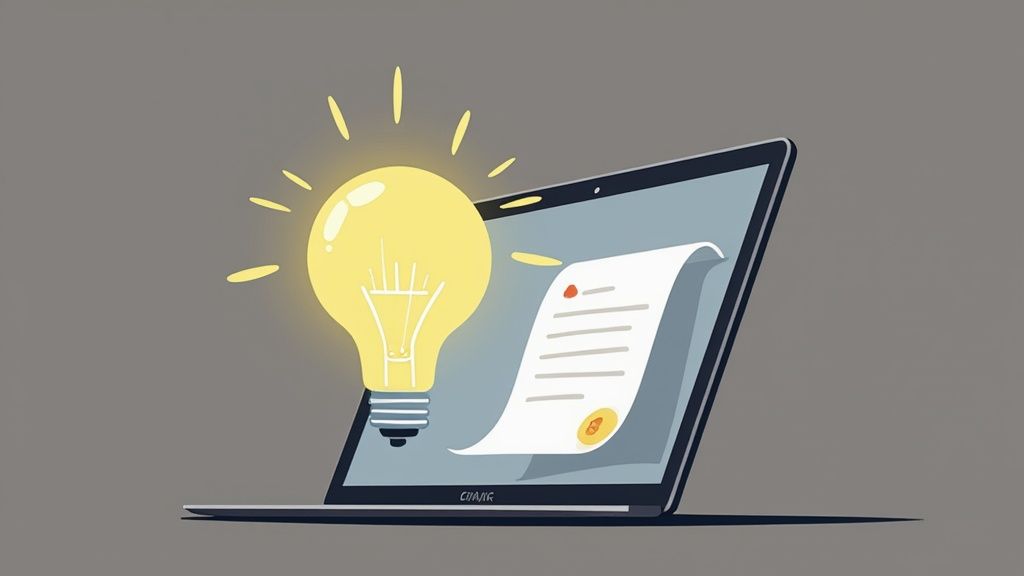
This approach works by demonstrating initiative and expertise. By going the extra mile and providing valuable information relevant to the conversation, you differentiate yourself from other candidates who may simply send a generic thank you. This proactive engagement leaves a lasting impression and reinforces your commitment to the role and the organization. It also subtly showcases your skills and knowledge, further solidifying your suitability for the position.
For instance, a marketing candidate could share a recent case study demonstrating successful campaign strategies similar to those discussed during the interview. An IT professional might provide links to articles on emerging technologies relevant to the company's technical challenges. A sales candidate could offer insights into market trends, competitor analysis, or even potential lead generation strategies. Consultants can provide frameworks or initial thoughts related to business challenges discussed during the interview process.
Here are some actionable tips for crafting an effective value-added follow-up email:
- Relevance is Key: Only include highly relevant and valuable content directly related to the interview discussion. Irrelevant information can dilute your message and even appear presumptuous.
- Brevity and Focus: Keep the additional content concise and focused. The goal is to add value, not overwhelm the hiring manager with excessive information.
- Credible Sources: Ensure any resources you share are from reputable and credible sources. This enhances your credibility and professionalism.
- Explicit Connection: Clearly connect the value-add to the interview conversation. Explain why you're sharing the resource and how it relates to the company’s needs or the discussed challenges.
- Thank You Remains Primary: Don’t let the added value overshadow the thank you message. Expressing gratitude should still be a central component of your email.
The value-added follow-up is especially effective when you’re interviewing for highly competitive roles where demonstrating initiative and a deep understanding of the industry are critical. This method is particularly valuable for influencer marketing professionals, digital and social media specialists, brand and content strategists, and anyone seeking remote opportunities. Recruiters and hiring managers in marketing, especially those within influencer marketing agencies, appreciate this proactive approach.
This strategy has been popularized by leading executive search firms like Korn Ferry and career coaches at top business schools. You can even find courses on crafting effective follow-up communication on platforms like LinkedIn Learning.
While this approach offers significant advantages, it’s important to be mindful of the potential downsides. If not executed carefully, it can appear presumptuous or even try-hard. It requires significant research and preparation to identify and curate truly valuable content. If the information is irrelevant or poorly chosen, it can backfire and negatively impact your candidacy.
The benefits, however, often outweigh the risks. A well-crafted value-added follow-up email can significantly differentiate you from other candidates, demonstrate your expertise and initiative, and provide tangible value to the employer. It shows genuine engagement with the company’s challenges and creates a memorable impression that can help you secure the job. Learn more about Value-Added Follow-Up Email. This kind of after interview email sample can be a powerful tool in your job search arsenal.
3. Clarification and Additional Information Email
This type of after-interview email, the Clarification and Additional Information email, allows you to address any areas where you feel you could have provided a stronger or clearer response during the interview. It's an opportunity to supplement your initial answers, provide further context, or even correct any misunderstandings that might have arisen. This approach demonstrates proactive thinking, attention to detail, and a genuine interest in the position, ultimately strengthening your candidacy. It’s about ensuring the interviewer has a complete and accurate understanding of your qualifications and experience, maximizing your chances of progressing to the next stage.
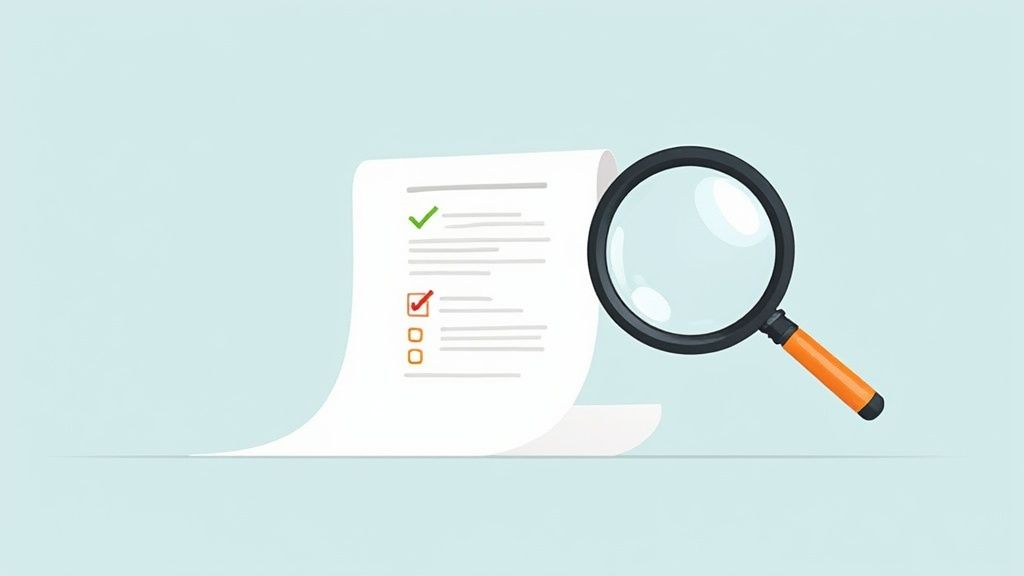
This strategy deserves a spot on this list because it transforms potential interview weaknesses into opportunities for demonstrating self-awareness and a commitment to continuous improvement. While other after-interview emails focus on expressing gratitude or reiterating interest, the Clarification and Additional Information email goes further by actively shaping the interviewer's perception of your capabilities. It allows you to proactively control the narrative, ensuring key qualifications and experiences are clearly understood.
Features of a Clarification and Additional Information Email:
- Addresses incomplete or unclear responses: Did you stumble over a technical question or feel your answer lacked sufficient detail? This email provides a second chance to deliver a polished and comprehensive response.
- Provides additional context or examples: Perhaps you mentioned a successful marketing campaign but didn't have time to delve into the specifics. This email allows you to showcase concrete results and metrics.
- Clarifies potential misunderstandings: Did you feel you weren't able to accurately convey a particular skill or experience? This email allows you to clarify and ensure accurate understanding.
- Expands on relevant experience: You might have briefly touched on a relevant project during the interview. This email allows you to expand on your role and contributions, highlighting your accomplishments.
- Shows reflective thinking about the interview: Sending this email demonstrates that you’ve carefully considered the conversation and are committed to providing the interviewer with the most complete picture of your abilities.
Pros:
- Opportunity to improve weak interview moments: Turn a potentially negative experience into a positive one by demonstrating a proactive approach to addressing shortcomings.
- Shows self-awareness and continuous improvement mindset: This email conveys that you are self-reflective and committed to learning and growth.
- Ensures key qualifications are communicated: Reinforce and elaborate on your key skills and experiences to solidify your fit for the role.
- Demonstrates attention to detail: Shows that you are thorough and committed to providing complete information.
- Can turn potential negatives into positives: By addressing perceived weaknesses head-on, you demonstrate confidence and initiative.
Cons:
- May draw attention to interview weaknesses: If not handled carefully, it might highlight areas where you initially fell short.
- Risk of over-explaining or appearing defensive: Avoid lengthy justifications; focus on providing concise and valuable information.
- Could suggest poor interview preparation: While this email can mitigate preparation gaps, over-reliance on it might suggest inadequate initial preparation.
- Might come across as lacking confidence: If not framed correctly, it could be perceived as second-guessing yourself or lacking confidence in your initial responses.
Examples:
- A software developer provides code samples related to the technical questions discussed in the interview.
- A project manager shares a case study detailing the successful outcomes and metrics of a previous project.
- A content strategist provides links to published articles or successful content marketing campaigns they developed.
- An influencer marketing manager clarifies campaign reach metrics and engagement rates for a specific influencer collaboration.
Tips for Writing an Effective Clarification and Additional Information Email:
- Frame additions positively: Present the additional information as supplementary details rather than corrections.
- Be concise and specific: Avoid rambling or lengthy explanations; focus on providing clear and relevant information.
- Focus on strengthening your candidacy: Emphasize how the additional information reinforces your qualifications for the role.
- Only address significant gaps or misunderstandings: Don't nitpick minor details; focus on areas that could significantly impact the interviewer's perception of your candidacy.
- Maintain a confident and professional tone: Project confidence and enthusiasm while remaining professional and respectful.
By following these guidelines, you can craft a Clarification and Additional Information email that strengthens your application and leaves a positive lasting impression. This approach demonstrates a proactive and thoughtful approach to the interview process, setting you apart from other candidates.
4. Panel Interview Group Thank You Email
Navigating the complexities of a panel interview requires a delicate balance of professionalism and personalized appreciation. Following up with a well-crafted thank you email is crucial, demonstrating not only your gratitude but also your organizational skills and understanding of team dynamics. This specialized approach, the Panel Interview Group Thank You Email, addresses the unique challenge of thanking multiple interviewers, either through individual personalized emails or a carefully crafted group message. This requires strategic thinking about personalization while managing multiple stakeholder relationships, making it a vital tool in your job search arsenal, particularly for roles involving multiple decision-makers. This approach ensures that each interviewer feels valued for their time and contribution to the hiring process, further solidifying your positive impression.
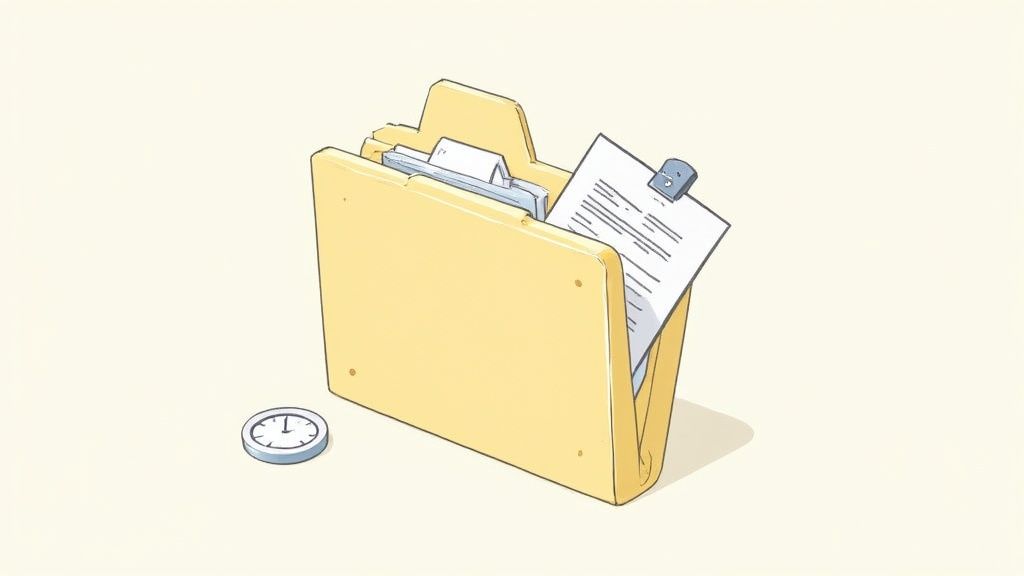
This method deserves a place on this list due to the increasing prevalence of panel interviews across various industries. Whether you're interviewing with a consulting firm, a healthcare organization with department head panels, an academic institution with a faculty search committee, or a tech company with engineering team interviews, understanding how to effectively thank multiple interviewers is essential for success. The Panel Interview Group Thank You Email distinguishes itself from a standard thank you note by acknowledging the collective effort of the panel while still offering personalized touches.
Key features of a successful Panel Interview Group Thank You Email include addressing multiple interviewers appropriately, balancing efficiency with personalization, acknowledging different interviewer roles, and maintaining professional courtesy across all contacts. It also importantly references the panel dynamics positively, demonstrating your appreciation for the collaborative environment. This demonstrates a deep understanding of corporate hierarchy and strengthens your candidacy.
The pros of using this approach are numerous. It ensures no interviewer feels overlooked, demonstrates strong organizational skills, shows respect for team dynamics, provides an efficient way to maintain multiple relationships, and reflects your understanding of corporate hierarchy. However, there are also cons to consider. Personalizing emails for each person can be more time-consuming, there's a risk of sending the wrong version to the wrong person, and a group approach might feel less personal. It also requires research on each interviewer's role and contributions to the panel.
Here’s how you can effectively implement the Panel Interview Group Thank You Email:
- Individual Emails (Ideal): Craft separate emails for each interviewer, referencing specific points discussed and tailoring your message to their role. For example, if you spoke with the head of marketing about brand strategy, reiterate your interest and mention a relevant article you read. If you discussed team dynamics with the HR manager, express your enthusiasm for the collaborative environment.
- Group Email (If Necessary): If individual emails are impractical, address the group email to all interviewers, acknowledging each person by name in the salutation and referencing the overall positive experience of the panel interview. Include general comments that apply to the entire panel, like your excitement about the company's culture or innovative projects.
Learn more about Panel Interview Group Thank You Email for additional insights into remote interview best practices, which can be particularly relevant for virtual panel interviews.
Here are some actionable tips for crafting impactful Panel Interview Group Thank You Emails:
- Prioritize Seniority: Send individual emails whenever possible for senior positions or key decision-makers.
- Personalize with Specifics: Reference each person's specific questions or comments from the interview, demonstrating your active listening and engagement.
- Research on LinkedIn: Research each interviewer's background on LinkedIn to personalize your message and connect with their professional interests.
- Consistent Messaging, Personalized Details: Maintain a consistent core message across all emails while incorporating personalized details to demonstrate individual attention.
- Timely Follow-Up: Send your thank you email within 24 hours to all panel members to maintain momentum and show your continued interest.
By understanding the nuances of the Panel Interview Group Thank You Email, you can effectively navigate this crucial step in the interview process, leaving a lasting positive impression on the entire panel and significantly increasing your chances of landing the job, particularly in competitive fields like influencer marketing and digital strategy. It's a valuable tool for any job seeker aiming to showcase not only their skills and experience but also their professionalism and appreciation for the collaborative hiring process. This approach can be particularly effective for influencer marketing professionals, digital and social media specialists, brand and content strategists, job seekers seeking remote opportunities, and recruiters and hiring managers in marketing and influencer marketing agencies.
5. Post-Interview Assignment Follow-Up Email: Showcase Your Skills and Commitment
The post-interview assignment follow-up email is a crucial tool in your job search arsenal, particularly when an interviewer requests additional materials like a take-home assignment, portfolio, presentation, or work sample. This type of after interview email sample goes beyond a simple thank you; it accompanies the deliverables, demonstrating your ability to meet deadlines, follow instructions, and showcase your skills in a tangible way. This proactive approach transforms a potential weakness – extra work outside the interview – into a powerful strength – a concrete demonstration of your capabilities. This is why it deserves a prominent place in any list of effective post-interview communication strategies.
This approach works by combining gratitude for the opportunity with a professional presentation of the requested materials. It’s a chance to reiterate your interest in the position while providing concrete evidence of your qualifications. This email isn't just about delivering the assignment; it’s about framing your work, highlighting your process, and reinforcing your fit within the company.
When to use this approach:
This type of after interview email sample is specifically designed for situations where you’ve been asked to complete a post-interview assignment. This could include:
- Take-home assignments: These assess your problem-solving skills and ability to apply your knowledge practically.
- Portfolio submissions: Common in creative fields, portfolios allow you to showcase previous work and highlight your skills and style.
- Presentations: These may involve presenting a case study, proposing a solution to a business problem, or outlining a marketing strategy.
- Coding challenges: Often used in tech roles, these test your coding proficiency and problem-solving abilities.
- Writing samples: Relevant for content creation, marketing, and communication roles, these demonstrate your writing style and ability to create engaging content.
Examples of Successful Implementation:
- A design candidate submitting a curated selection of portfolio pieces tailored to the company's aesthetic, accompanied by a brief explanation of the design choices for each piece.
- A marketing professional providing a detailed campaign strategy, outlining the target audience, channels, and key performance indicators, along with a summary of their strategic approach.
- A data analyst delivering a comprehensive data analysis report, including visualizations and clear explanations of the findings, along with a description of the methodologies used.
- A software developer submitting a clean and well-documented solution to a coding challenge, highlighting their coding style and problem-solving approach.
- A writer providing polished content samples tailored to the company’s target audience and content pillars, explaining their approach to content creation.
Features of an Effective Post-Interview Assignment Follow-Up Email:
- Accompanies deliverables: The primary purpose is to deliver the requested materials.
- Explains approach/methodology: Briefly describe your thought process and the steps you took to complete the assignment.
- Meets deadlines and requirements: Adhering to the specified guidelines demonstrates professionalism and attention to detail.
- Maintains professional presentation standards: Ensure all materials are well-formatted, clearly labeled, and easy to navigate.
- Invites feedback and questions: Show that you are open to discussion and eager to learn.
Pros:
- Demonstrates commitment: Shows you are willing to go the extra mile.
- Showcases work quality and attention to detail: Provides tangible evidence of your skills and abilities.
- Provides concrete evidence of skills: Moves beyond claims on your resume and provides real-world examples of your capabilities.
- Shows respect for the interviewer’s time and process: Following instructions and meeting deadlines demonstrates respect.
- Creates opportunity for further engagement: Provides a natural opening for follow-up communication.
Cons:
- Additional time investment: Completing assignments requires time and effort beyond the initial interview.
- Risk of over or under-delivering: It can be challenging to gauge the interviewer's expectations.
- Competition: You may be competing against other candidates who are also submitting assignments.
- Technical issues: Problems with file formatting or attachments can negatively impact your submission.
Actionable Tips:
- Follow submission guidelines exactly. Pay close attention to file formats, naming conventions, and any specific instructions provided.
- Include a brief explanation of your approach. This helps the interviewer understand your thought process and rationale.
- Ensure all files are properly formatted and named. Use clear and descriptive file names to make it easy for the interviewer to navigate your materials.
- Test all links and attachments before sending. Ensure everything works as expected to avoid technical difficulties.
- Ask for confirmation of receipt. This ensures your submission has been received and allows you to address any potential issues promptly.
This type of after interview email sample is particularly popular in fast-paced and competitive industries like tech, consulting, and marketing, where companies often require tangible evidence of a candidate's skills and abilities. By crafting a thoughtful and professional post-interview assignment follow-up email, you can significantly increase your chances of standing out from the competition and securing the job.
6. Post-Rejection Re-engagement Email: Turning a "No" into a "Not Now"
Receiving a rejection email after an interview can be disheartening. However, a well-crafted post-rejection re-engagement email can transform this seemingly final endpoint into a potential future opportunity. This type of after interview email sample demonstrates resilience, emotional intelligence, and a commitment to building long-term professional relationships. It allows you to leave a positive lasting impression, even when the immediate outcome isn't what you hoped for. This strategic approach is particularly valuable in today’s interconnected professional world, where networking and relationship-building are crucial for career advancement.
This method involves sending a brief, professional, and gracious email after receiving a rejection notice. The aim isn't to contest the decision, but rather to acknowledge the outcome, express continued interest in the company, and potentially gain valuable feedback. This approach reframes the rejection as a "not now" rather than a definitive "no," keeping the door open for future possibilities within the organization.
Why use a post-rejection re-engagement email?
The benefits of sending this type of after interview email sample are numerous. It maintains positive professional relationships, crucial in any industry, particularly for influencer marketing professionals, digital and social media specialists, and brand strategists. It showcases your emotional maturity and professionalism to recruiters and hiring managers, qualities highly valued in any candidate. Furthermore, it can provide valuable feedback for improvement, which can be instrumental in future job searches. Finally, and perhaps most importantly, it can keep doors open for future opportunities within the company. New positions open up frequently, and your thoughtful follow-up could position you as a top-of-mind candidate when they do.
Examples of Successful Implementation:
This strategy isn't just theoretical; it has tangible success stories. There are numerous instances where candidates who sent post-rejection re-engagement emails were later hired for different roles within the same company. Sometimes, these individuals even transitioned into vendor or partner relationships with the organization, demonstrating the long-term value of maintaining positive connections. Networking opportunities fostered through these emails can also lead to referrals elsewhere, broadening your career prospects. Finally, the feedback received through this process has helped countless candidates refine their interview skills and ultimately land their dream roles.
Features of an Effective Post-Rejection Re-engagement Email:
- Gracious Acceptance: Acknowledge and accept the decision without contesting it.
- Gratitude: Express sincere thanks for their time and consideration.
- Feedback Request (Optional): Politely request feedback if the company culture permits it.
- Continued Interest: Reiterate your interest in the company and future opportunities.
- Professional Tone: Maintain a professional and positive tone despite the disappointment.
Actionable Tips for Crafting Your Email:
- Wait 24-48 Hours: Allow time to process your emotions before writing. This ensures a composed and thoughtful message.
- Keep it Brief: Respect the recipient's time with a concise and to-the-point email.
- Genuine Gratitude: Express specific appreciation for the interviewer's time and insights. For instance, mention something specific you discussed or learned during the interview process.
- Feedback Focus: If requesting feedback, focus on specific areas where you feel you could improve. For example, you might ask for feedback on your presentation skills or your understanding of the role.
- Avoid Reconsideration: Do not ask for reconsideration of the decision. Accept the outcome gracefully.
Pros and Cons of Sending a Post-Rejection Re-engagement Email:
Pros:
- Maintains positive professional relationships.
- Demonstrates emotional maturity and resilience.
- Keeps doors open for future opportunities.
- May provide valuable feedback for improvement.
- Leaves a positive lasting impression.
Cons:
- Emotionally challenging to write after rejection.
- May not receive a response or feedback.
- Risk of appearing not to accept the decision (if not worded carefully).
- Time investment with uncertain return.
Popularized By:
The practice of sending post-rejection re-engagement emails has been popularized by executive coaches, career development professionals, business school career services departments, and professional networking organizations. They recognize the long-term value of maintaining positive relationships and the potential for turning a setback into a future opportunity.
By using this after interview email sample strategy, you can demonstrate professionalism, build valuable connections, and potentially turn a rejection into a stepping stone toward your career goals. Remember, a “no” today doesn’t necessarily mean a “no” forever.
6 After-Interview Email Types Compared
| Email Type | Implementation Complexity 🔄 | Resource Requirements ⚡ | Expected Outcomes 📊 | Ideal Use Cases 💡 | Key Advantages ⭐ |
|---|---|---|---|---|---|
| Standard Thank You Follow-Up Email | Low - simple, brief, sent within 24 hours | Minimal - only writing and proofreading | Reinforces professionalism and positive impression | Most post-interview situations | Universally expected, low risk, demonstrates courtesy |
| Value-Added Follow-Up Email | Medium - requires research and customization | Moderate - time for research and drafting | Differentiates candidate, shows initiative | When candidate can add relevant insights/resources | Demonstrates expertise, creates memorable impression |
| Clarification and Additional Info Email | Medium - thoughtful composition to clarify | Moderate - gathering examples or context | Corrects misunderstandings, strengthens candidacy | If interview had unclear or incomplete answers | Shows self-awareness, turns potential negatives positive |
| Panel Interview Group Thank You Email | High - multiple personalized emails or group | Higher - research individual roles, track questions | Maintains relationships with multiple interviewers | Panel or group interviews | Demonstrates organizational skills, respects team dynamics |
| Post-Interview Assignment Follow-Up Email | Medium - preparing and submitting deliverables | Moderate - creating or finalizing assignment | Shows skills concretely, confirms commitment | When assignments or portfolios requested | Provides tangible proof of ability, encourages further engagement |
| Post-Rejection Re-engagement Email | Low to Medium - careful tone needed | Low - writing gracious and professional message | Maintains relationships, may open future doors | After receiving rejection | Demonstrates emotional maturity, keeps future opportunities |
Land Your Dream Influencer Marketing Job
Mastering the art of the follow-up email is a crucial skill for any job seeker, especially in a competitive field like influencer marketing. Throughout this article, we've explored six distinct after interview email sample options, ranging from standard thank you notes to post-rejection re-engagement strategies. The key takeaways are to always personalize your message, reiterate your value, and maintain professionalism, no matter the circumstance. Remember, each email is an opportunity to reinforce your interest and demonstrate your communication skills—essential qualities for success in influencer marketing.
By adapting these after interview email samples to your specific situation, you can significantly increase your chances of landing your dream role. Effective communication can be the deciding factor between you and another equally qualified candidate. These techniques not only help you express gratitude and maintain professionalism but also keep you top-of-mind with potential employers. Imagine the impact of a well-crafted email showcasing your understanding of the role and your enthusiasm for the company. This can be the edge you need to secure that coveted offer.
Ready to take the next step in your influencer marketing career? Discover your perfect role on Influencer Marketing Jobs. We specialize in connecting top talent with exciting opportunities in the ever-evolving world of influencer marketing, making your job search more efficient and effective after nailing those follow-up emails.